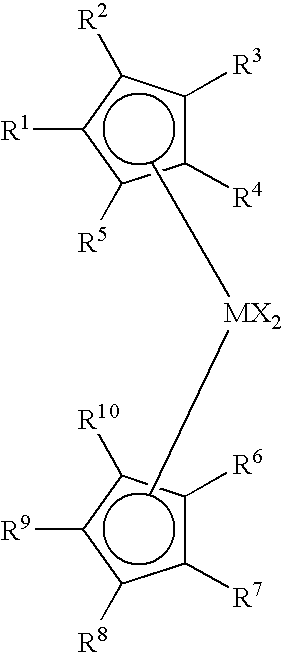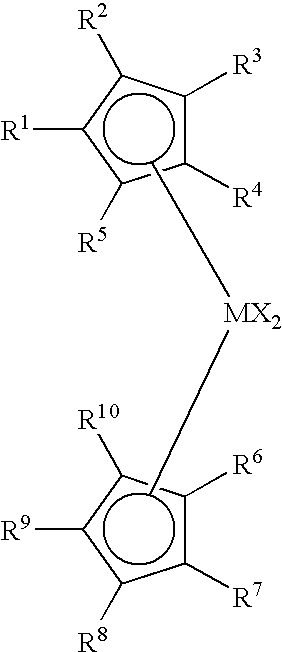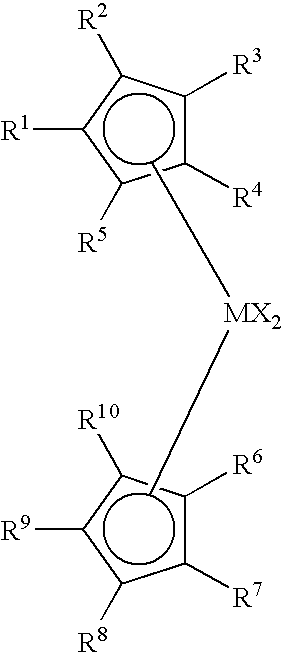Process to produce low viscosity poly-alpha-olefins
a technology of alpha-olefins and polyalpha-olefins, which is applied in the direction of lubricant compositions, chemistry apparatus and processes, organic chemistry, etc., can solve the problems of increasing performance requirements of lubricants and pao's made with metallocenes that have not found wide applicability in the marketpla
- Summary
- Abstract
- Description
- Claims
- Application Information
AI Technical Summary
Problems solved by technology
Method used
Image
Examples
examples
[0419]Fluid properties were measured by following standard methods, except when described otherwise: kinematic viscosity at 40 and 100° C. in cSt by ASTM 445 method; pour point by ASTM D97 method; and viscosity index (VI) according to ASTM D2270.
[0420]The following examples are for purposes of illustration only and are non-limiting examples.
[0421]The 1-decene used for all of the experiments was purified by mixing 1 liter of untreated raw material with 20 grams of activated 13X molecular sieve, (which was activated by calcining at 200° C. for at least four hours under a stream of purging dry nitrogen gas), and 10 grams of Oxi-Clear catalyst (purchased from Altech Associates, Inc of Deerfield, Ill. 60115) for at least two days inside a glove box under a dry, inert atmosphere of nitrogen. The molecular sieve and de-oxygenation catalyst were then removed by filtration in the glove box to provide purified 1-decene. Alternatively, the feeds were purified by passing through a bed of activa...
example 9
[0428]Batch Runs—In these runs, a catalyst solution containing 10 mg TNOAL, 1.6 mg catalyst 1 and 3.84 mg of dimethylaniliniumperfluorotetraphenylborate in 20 gram toluene solution was added to an autoclave containing 90 gram of 1-decene and 80 mg of TNOAL heated to reaction temperature under hydrogen pressure. The reaction was then discontinued after 4 hours by injecting 10 gram of solid alumina. The product was isolated by filtration to remove any solid residual, distilled at 100° C. under vacuum to remove toluene or unreacted olefins followed by distillation at 160° C. / <1 milli-torr vacuum to remove light ends. The reaction conditions and residual olefinic polymer properties and compositions are summarized in Table 4. In all of the following experiments the molar ratio of TNOAl scavenger to catalyst was 60, and the molar ratio of activator to catalyst was 1.0. The residual fraction of some runs was further hydrogenated with hydrogen with 2 wt % of a 50% Nickle on Kieselguhr catal...
example 10
Continuous Runs
[0430]This set of experiments was carried out in a continuous reactor process. 1-decene and toluene used in the runs were sparged with nitrogen and then purified through a 5-Angstrom molecular sieve. The metallocene catalyst used was Catalyst 1, preactivated with N,N-dimethylanilinium tetra(pentafluorophenyl)borate with equal molar amounts of metallocene and activator in toluene solution. The experiments were conducted in a series dual-reactor continuous process. Both of the reactors were 1-liter autoclave reactors. All feeds were introduced into the first reactor and products were continuously withdrawn from the second reactor. Both of the reactors were controlled at the same reaction temperature. The product isolation and hydrogenation were similar to that of Example 9. The polymerization conditions and product properties after hydrogenation are summarized in Table 5.
[0431]
TABLE 51-Decene Oligomerization in Continuous ProcessMetallocene1111Temp (° C.)1001001201201-d...
PUM
| Property | Measurement | Unit |
|---|---|---|
| kinematic viscosity | aaaaa | aaaaa |
| kinematic viscosity | aaaaa | aaaaa |
| kinematic viscosity | aaaaa | aaaaa |
Abstract
Description
Claims
Application Information
 Login to View More
Login to View More - R&D
- Intellectual Property
- Life Sciences
- Materials
- Tech Scout
- Unparalleled Data Quality
- Higher Quality Content
- 60% Fewer Hallucinations
Browse by: Latest US Patents, China's latest patents, Technical Efficacy Thesaurus, Application Domain, Technology Topic, Popular Technical Reports.
© 2025 PatSnap. All rights reserved.Legal|Privacy policy|Modern Slavery Act Transparency Statement|Sitemap|About US| Contact US: help@patsnap.com



